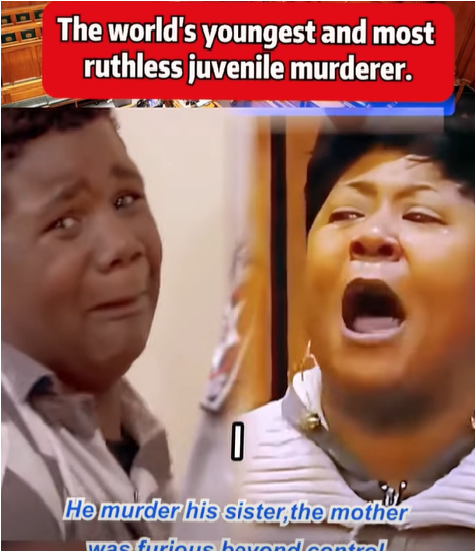
The courtroom was hushed—so quiet that the soft buzz of the overhead lights seemed deafening. Every bench was filled. Reporters lined the back wall, pens poised, cameras blinking. Even the most experienced attorneys shifted uneasily, as if the room itself sensed the weight of what was about to unfold.
At the front, small in frame but unnervingly composed, sat eleven-year-old Cyrus Hale, labeled by prosecutors as “the world’s youngest and most ruthless juvenile murderer.” He wore a navy sweater that hung loosely, sleeves draping over his hands. His face was expressionless, vacant, as if observing a play in which he had no part.
This was Day Four of a hearing that had shaken the nation and forced lawmakers to rethink their assumptions about childhood, accountability, and the nature of evil.
I. Judge Marwick Calls the Court to Order
“Bring the witness forward,” Judge Helena Marwick commanded, her tone steady but tinged with tension. She had overseen hundreds of trials, but never one like this.
A bailiff escorted Dr. Rowan Meritt, a child psychologist, to the stand. He appeared anxious—far more than an expert witness should.
“Dr. Meritt,” the prosecutor began, “you conducted extensive interviews with the defendant. In your professional opinion, does Cyrus Hale understand the consequences of his actions?”
A ripple of tension ran through the room. Every eye was on the witness.
Dr. Meritt replied:
“Yes. My evaluation indicates he not only understands but acted with deliberate calculation. His emotional responses are… highly atypical.”
Judge Marwick raised a brow.
“Atypical in what sense, Doctor?”
Dr. Meritt:
“He exhibits no empathy, no remorse, and no discernible fear—neither of punishment nor confrontation.”
Several victims’ family members dabbed at their tears. Cyrus remained still.
II. The Prosecutor Lays Out the “Plan”
Prosecutor Dana Whitlock stepped toward the center.
“Your Honor, evidence will show that Cyrus Hale meticulously planned this incident weeks ahead. He drew diagrams, calculated timing, and made lists of intended victims.”
The defense jumped to their feet.
“Objection! These documents are not verified—”
Judge Marwick held up a hand.
“Overruled. Proceed, Ms. Whitlock.”
Whitlock pressed a remote, and a large screen displayed a scanned notebook page—Cyrus’s handwriting neat, eerily mature. Across the top:
“People who ruin things.”
Her voice quiet, every word landed like a hammer.
“This was not impulsive. This was premeditated. Structured. Intentional.”
Cyrus’s eyes stayed on the page, as if it belonged to another child entirely.
III. The Defense Responds
Attorney Leo Garner addressed Dr. Meritt.
“Doctor, he is eleven. Eleven! At that age, the brain is still developing. Are you suggesting the court hold an eleven-year-old fully accountable like an adult?”
Dr. Meritt took a measured breath.
“I’m suggesting that Cyrus Hale’s psychological profile diverges significantly from typical childhood behavior. He shows traits consistent with severe behavioral disorders.”
Garner pressed on:
“But Doctor, you’re not asserting that rehabilitation is impossible?”
A pause.
“I am asserting that rehabilitation would require extraordinary time, resources, and specialized intervention.”
The murmurs in the courtroom grew louder. Judge Marwick struck her gavel.
IV. Cyrus Speaks
Until now, the boy had been silent, staring straight ahead. When asked if he wished to speak, he finally looked up—disturbingly still, like a statue awakening.
Judge Marwick:
“Cyrus, do you understand why you are here?”
Cyrus:
“Yes.”
Judge Marwick:
“And do you know what you’ve been accused of?”
He nodded slightly. Then, in a quiet voice:
“I made choices. People make choices every day.”
The judge frowned.
“Why did you make these choices?”
A tense silence followed. Cyrus blinked once.
“Because no one was listening.”
Some relatives sobbed openly, while others stared in disbelief.
V. Detective Testimon
Detective Marla Grayson, lead investigator, took the stand. She recounted the scene with clinical precision, avoiding gratuitous details but painting a picture of frightening organization.
Prosecutor Whitlock:
“Detective, could this have been the impulsive act of a child?”
Detective Grayson:
“No. Everything was planned, timed, and executed carefully. He evaded detection for nearly three hours. Many adults could not have carried out such a scheme.”
Garner objected:
“You’re attributing sophistication solely to Cyrus. Could an adult have influenced him?”
Grayson paused.
“No evidence of adult involvement exists. Every step traces directly to him.”
VI. The Courtroom Divides
As testimony continued, the debate grew heated:
- Should an eleven-year-old face the maximum juvenile sentence?
- Is Cyrus a product of neglect, or an anomaly of nature?
- Can someone so young truly grasp the value of life?
Experts argued. Parents cried. Journalists scribbled furiously. And Cyrus remained motionless—observing the chaos around him.
VII. Judge Marwick’s Closing Remarks
Before adjourning, Judge Marwick addressed the court:
“This trial is unlike any we have ever seen. The loss is immense. Yet the age of the defendant poses profound questions about accountability, psychology, and justice. Tomorrow, we will continue with deliberate care.”
Her gavel fell.
VIII. Outside the Courthouse
Crowds gathered behind barricades. Some demanded Cyrus be locked away permanently. Others called for compassion, rehabilitation, and mental health reform.
Inside a police vehicle, Cyrus was led away quietly, avoiding the cameras and the crowd—his gaze fixed on his hands, half-hidden beneath his sleeves.
No one knew the final verdict. But everyone knew one truth:
This case would forever change how the world views juvenile crime.



